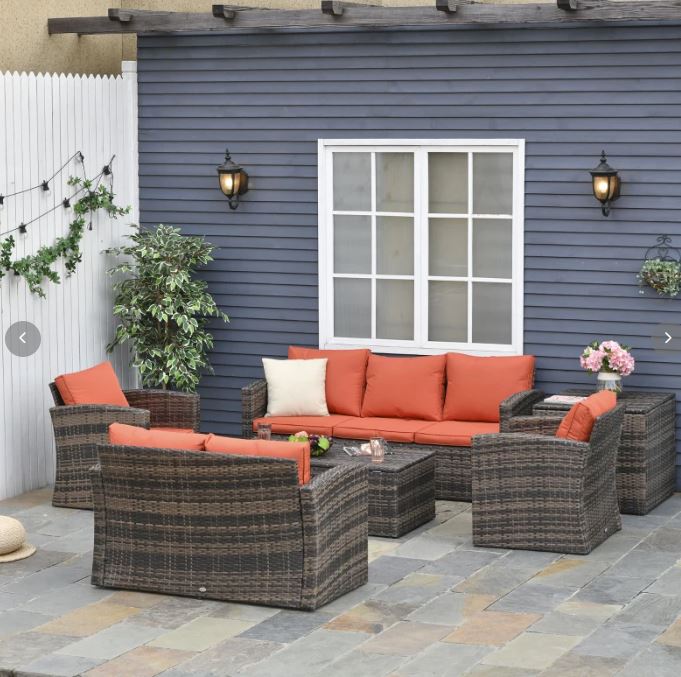You may have decided a rattan sofa set would work perfectly for your design aesthetic. But now you have to contemplate polyrattan vs rattan. What's the difference between natural rattan and plastic or synthetic rattan?
Let's look at these materials' unique qualities to help you select the best rattan furniture for your lifestyle.
What Is Rattan?
Rattan is a durable, flexible vine-like palm native to tropical regions of Asia and Africa. Known for its strength and lightweight, it's often used in furniture and basket weaving. Unlike bamboo, rattan is solid, making it ideal for crafting sturdy, eco-friendly furniture and decorative items.
What Is Polyrattan?
Polyrattan is a versatile material made from synthetic plastic fibres designed to look like natural rattan. It offers a few distinct advantages for outdoor use. Namely, it doesn't absorb water or suffer from UV damage like natural rattan.
Its durability makes polyrattan ideal for outdoor furniture. It gives you a stylish look that can withstand the elements with minimal upkeep. Plus, it's tough to tell synthetic rattan from the real thing, thanks to modern advancements. Hence, you get the beauty of natural rattan without the hassle of maintenance.
Key Takeaway: 💡 Polyrattan's incredible durability makes it a superior choice for consumers. This aligns with the trend toward stylish yet long-lasting outdoor living pieces, as highlighted in our ultimate guide to buying rattan garden furniture.
Polyrattan vs. Rattan
Polyrattan and natural rattan are similar but have a few nuanced differences. Here are the benefits of each material.
Benefits of Polyrattan
- Exceptional weather resistance: Polyrattan furniture, such as a polyrattan sofa, is exceptionally resistant to weather conditions and UV rays, making it ideal for long-term outdoor use.
- Easy maintenance: A rattan alternative's non-absorbent, stain-resistant surface requires only a quick wipe to stay fresh and minimal upkeep.
- Resistance to UV rays and salt: Designed to resist UV rays, polyrattan won't fade or crack under sunlight, is resilient near salt water, and is ideal for coastal use.
- Customisable styles: Available in various colours, weaves, and finishes, rattan is an alternative that easily adapts to your decor preferences while maintaining durability.
Key Takeaway: 💡 Polyrattan is a technologically advanced and more durable alternative to natural rattan. It offers excellent value and sustainability, making it a smart choice for outdoor furniture.
Benefits of Natural Rattan
- Timeless aesthetic and versatility: Rattan furniture, including popular options like rattan sofas and rattan chairs, is ideal for creating a warm, earthy aesthetic in indoor or shaded outdoor spaces.
- Flexible yet durable: Natural rattan is solid and flexible, making it suitable for crafting comfortable, durable pieces like a rattan storage bench or sun loungers. When cared for properly, it withstands light outdoor use and can last for years.
- Breathable and lightweight: Natural rattan furniture is easy to move and breathable, adding comfort and ease to your space. Its airy structure allows for better airflow, making it ideal for warmer climates.
Eco-Sustainability of Polyrattan vs. Rattan
Polyrattan is a synthetic fibre typically made from polyethylene, polypropylene, polyvinyl chloride (PVC), or resin-based compounds. Although durable and recyclable, its production sometimes relies on fossil fuels, contributing to a larger carbon footprint than rattan. Recycling polyrattan requires specific facilities, which may not be accessible in all regions.
Rattan, derived from natural palm species, is renewable and biodegradable, potentially making it a more eco-friendly option. Its cultivation supports forest preservation in Southeast Asia by providing an alternative to deforestation. However, challenges include unsustainable harvesting in certain areas, which can threaten biodiversity and disrupt the delicate balance in habitats.
Key Takeaway: 💡 Regardless of whether you have your heart set on a rattan alternative or natural rattan for your garden furniture, such as rattan bistro sets, it's worth considering which sustainability factors are most important.
What Is the Difference Between Rattan and PE Rattan and Polyrattan?
Rattan is a natural material that comes from climbing palms in tropical forests, whereas PE rattan and polyrattan are rattan alternatives.
Specifically referring to polyethylene-based synthetic rattan, PE rattan is one of the most common types of polyrattan. People value PE rattan for its strength, flexibility, and environmental advantages over other plastics. High-quality PE rattan can often be recycled, unlike cheaper synthetic rattans, which may break down faster and are less eco-friendly.
Key Takeaway: 💡 If you value sustainability in your rattan material, PE rattan may be a wise choice.
Frequently Asked Questions
Is polyrattan the same as rattan?
Polyrattan, also known as synthetic rattan, is an artificial material designed to mimic natural rattan in appearance. It is commonly made from polyethylene, which makes it more durable and weather-resistant.
Is polyrattan any good?
Yes, polyrattan is an excellent choice for outdoor furniture due to its resilience, easy maintenance, and ability to withstand harsh weather conditions without fading or cracking.
Is polyrattan waterproof?
Polyrattan is waterproof and resistant to moisture, which helps prevent mould or mildew growth. This makes it ideal for outdoor settings where exposure to rain or humidity is common.
How long does polyrattan last?
With proper care, polyrattan furniture can last 5-10 years or more, even when exposed to outdoor conditions, due to its durable synthetic composition.
How durable is plastic and polyrattan garden furniture?
Plastic garden furniture is generally affordable and weather-resistant, but polyrattan is more durable and long-lasting due to its resilience against weather and UV exposure.
What are the primary materials used in plastic garden furniture?
Plastic garden furniture is often made from polypropylene, polyrattan, polywood, and textilene, each providing weather resistance and durability.
How does polyrattan compare to natural rattan in terms of sustainability?
While polyrattan mimics the look of natural rattan, it's made from mineral oil-based plastic, which raises sustainability concerns.
What are the drawbacks of plastic garden furniture?
Plastic garden furniture is prone to heat buildup, fading, and brittleness over time and is susceptible to oils or grease stains.
Is plastic garden furniture environmentally friendly?
Plastic garden furniture has a significant environmental impact, but opting for recycled materials can help reduce its footprint.

